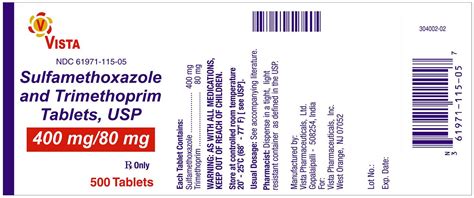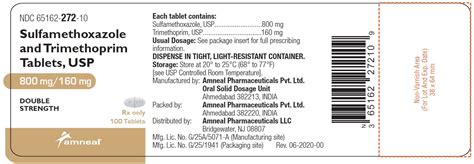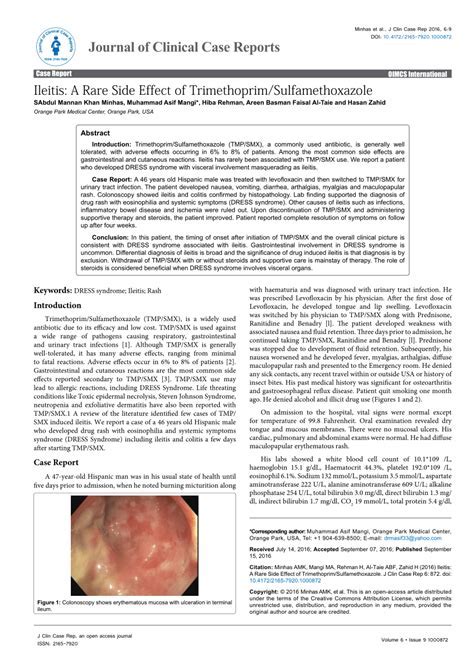Intro
Discover the uses and side effects of Sulfamethoxazole Trimethoprim, a commonly prescribed antibiotic combination. Learn how it treats urinary tract infections, bronchitis, and other bacterial infections, as well as potential interactions and adverse reactions, including allergic responses, gastrointestinal issues, and antibiotic resistance.
Sulfamethoxazole trimethoprim, also known as co-trimoxazole, is a widely used antibiotic combination that has been prescribed for decades to treat various bacterial infections. This medication is a blend of two active ingredients: sulfamethoxazole, a sulfonamide antibiotic, and trimethoprim, a dihydrofolate reductase inhibitor. Together, they work synergistically to combat bacterial infections by inhibiting the growth of bacteria and preventing them from reproducing.
The combination of sulfamethoxazole and trimethoprim has been found to be effective against a broad range of bacterial infections, including urinary tract infections (UTIs), respiratory tract infections, skin and soft tissue infections, and gastrointestinal infections. It is also used to treat certain types of bacterial infections in people with weakened immune systems, such as those with HIV/AIDS.

How Does Sulfamethoxazole Trimethoprim Work?
Sulfamethoxazole and trimethoprim work together to inhibit the growth of bacteria by targeting two different stages of the bacterial replication process. Sulfamethoxazole blocks the production of folic acid, a nutrient essential for bacterial growth, while trimethoprim inhibits the enzyme dihydrofolate reductase, which is necessary for the synthesis of folic acid. By blocking these two stages, sulfamethoxazole trimethoprim effectively prevents bacteria from reproducing and ultimately leads to their death.
Mechanism of Action
The mechanism of action of sulfamethoxazole trimethoprim involves the following steps:
- Sulfamethoxazole competes with para-aminobenzoic acid (PABA) for the enzyme dihydropteroate synthase, which is necessary for the synthesis of folic acid.
- Trimethoprim inhibits the enzyme dihydrofolate reductase, which is necessary for the conversion of dihydrofolate to tetrahydrofolate.
- The combination of sulfamethoxazole and trimethoprim blocks the production of folic acid, which is essential for bacterial growth and replication.
Uses of Sulfamethoxazole Trimethoprim
Sulfamethoxazole trimethoprim is used to treat a wide range of bacterial infections, including:
- Urinary tract infections (UTIs)
- Respiratory tract infections, such as bronchitis and pneumonia
- Skin and soft tissue infections, such as cellulitis and abscesses
- Gastrointestinal infections, such as diverticulitis and inflammatory bowel disease
- Certain types of bacterial infections in people with weakened immune systems, such as those with HIV/AIDS

Urinary Tract Infections (UTIs)
Sulfamethoxazole trimethoprim is commonly used to treat UTIs, which are bacterial infections that occur in the urinary tract. UTIs can occur in the kidneys, bladder, or urethra and can cause symptoms such as burning during urination, frequent urination, and abdominal pain.
Respiratory Tract Infections
Sulfamethoxazole trimethoprim is also used to treat respiratory tract infections, such as bronchitis and pneumonia. These infections occur in the lungs and can cause symptoms such as coughing, wheezing, and difficulty breathing.
Side Effects of Sulfamethoxazole Trimethoprim
Like all medications, sulfamethoxazole trimethoprim can cause side effects, some of which can be serious. Common side effects include:
- Nausea and vomiting
- Diarrhea
- Abdominal pain
- Headache
- Dizziness
- Rash

Serious Side Effects
In rare cases, sulfamethoxazole trimethoprim can cause serious side effects, including:
- Anaphylaxis, a severe allergic reaction that can cause difficulty breathing and swallowing
- Stevens-Johnson syndrome, a rare skin and mucous membrane disorder that can cause blistering and peeling
- Toxic epidermal necrolysis, a rare skin disorder that can cause blisters and peeling
- Blood disorders, such as agranulocytosis and thrombocytopenia
Interactions with Other Medications
Sulfamethoxazole trimethoprim can interact with other medications, including:
- Blood thinners, such as warfarin
- Diabetes medications, such as metformin
- Seizure medications, such as phenytoin
- Cyclosporine, a medication used to prevent organ rejection in transplant patients

Conclusion
Sulfamethoxazole trimethoprim is a widely used antibiotic combination that has been prescribed for decades to treat various bacterial infections. While it can be an effective treatment option, it is essential to be aware of its potential side effects and interactions with other medications. If you are prescribed sulfamethoxazole trimethoprim, be sure to follow the instructions carefully and report any side effects to your doctor.
We invite you to share your experiences with sulfamethoxazole trimethoprim in the comments section below. Have you taken this medication before? What were your experiences with it? Share your stories and help others who may be considering this treatment option.
What is sulfamethoxazole trimethoprim used for?
+Sulfamethoxazole trimethoprim is used to treat various bacterial infections, including urinary tract infections, respiratory tract infections, skin and soft tissue infections, and gastrointestinal infections.
How does sulfamethoxazole trimethoprim work?
+Sulfamethoxazole trimethoprim works by inhibiting the growth of bacteria by targeting two different stages of the bacterial replication process.
What are the common side effects of sulfamethoxazole trimethoprim?
+Common side effects of sulfamethoxazole trimethoprim include nausea and vomiting, diarrhea, abdominal pain, headache, dizziness, and rash.
